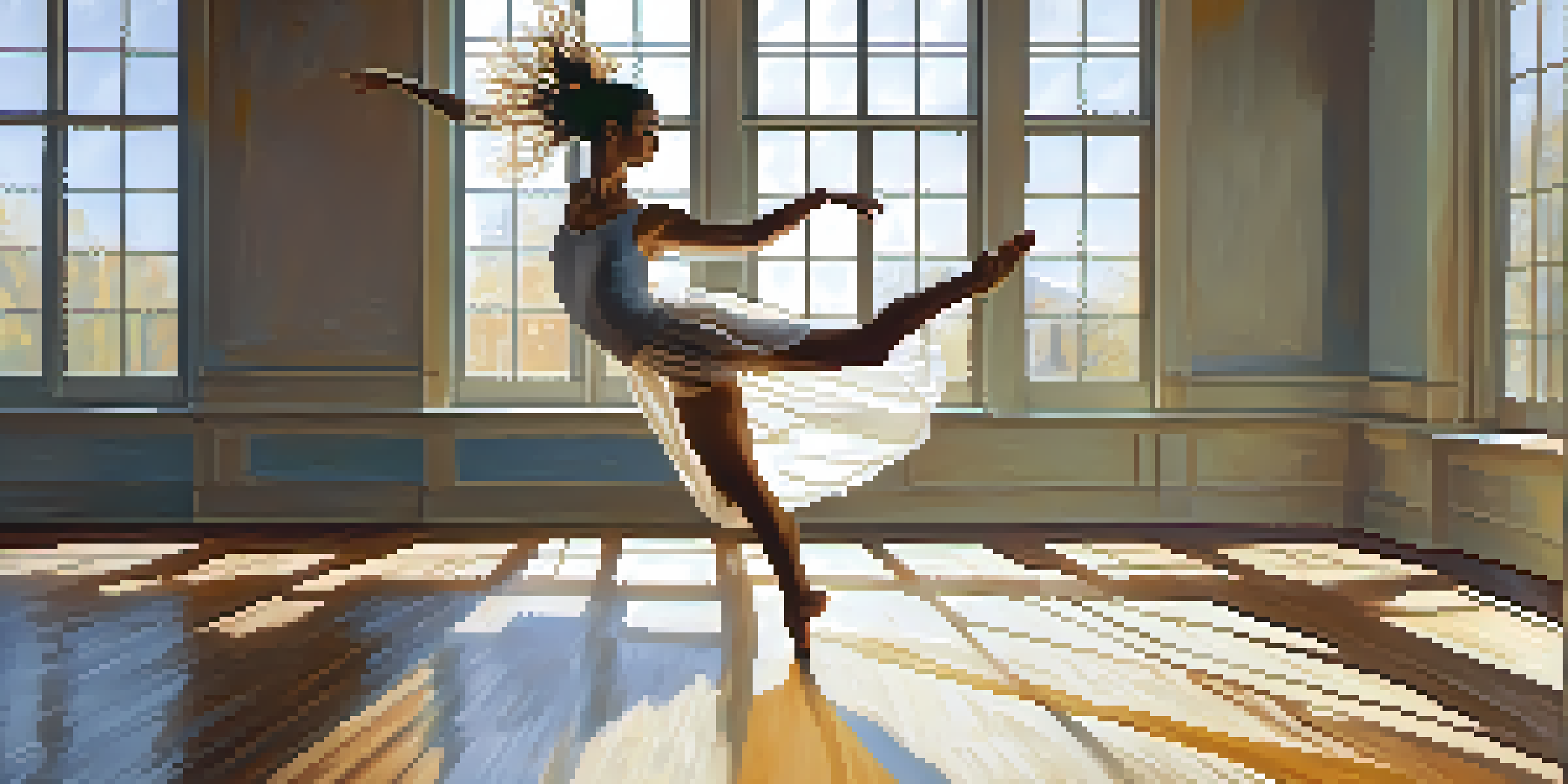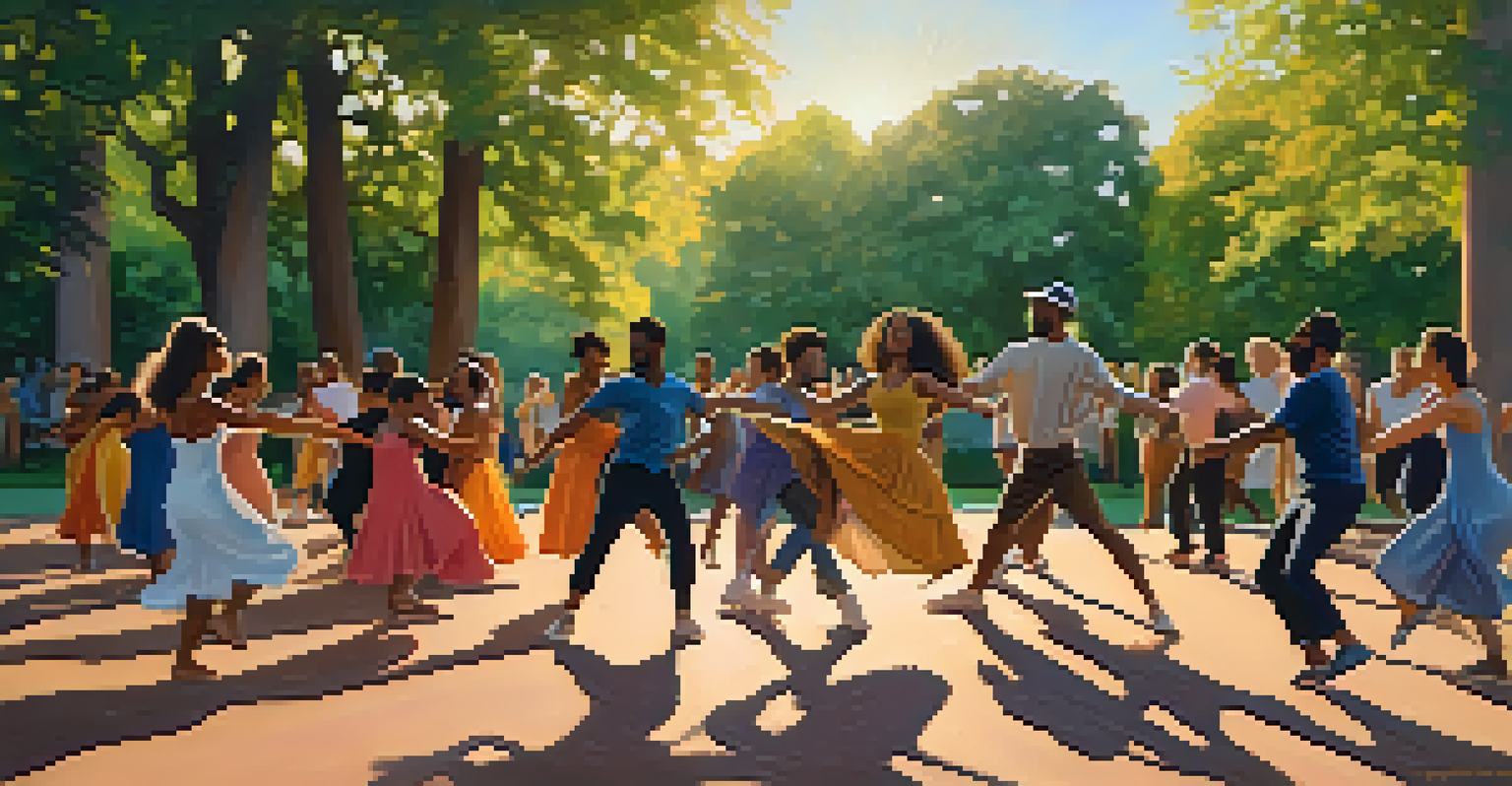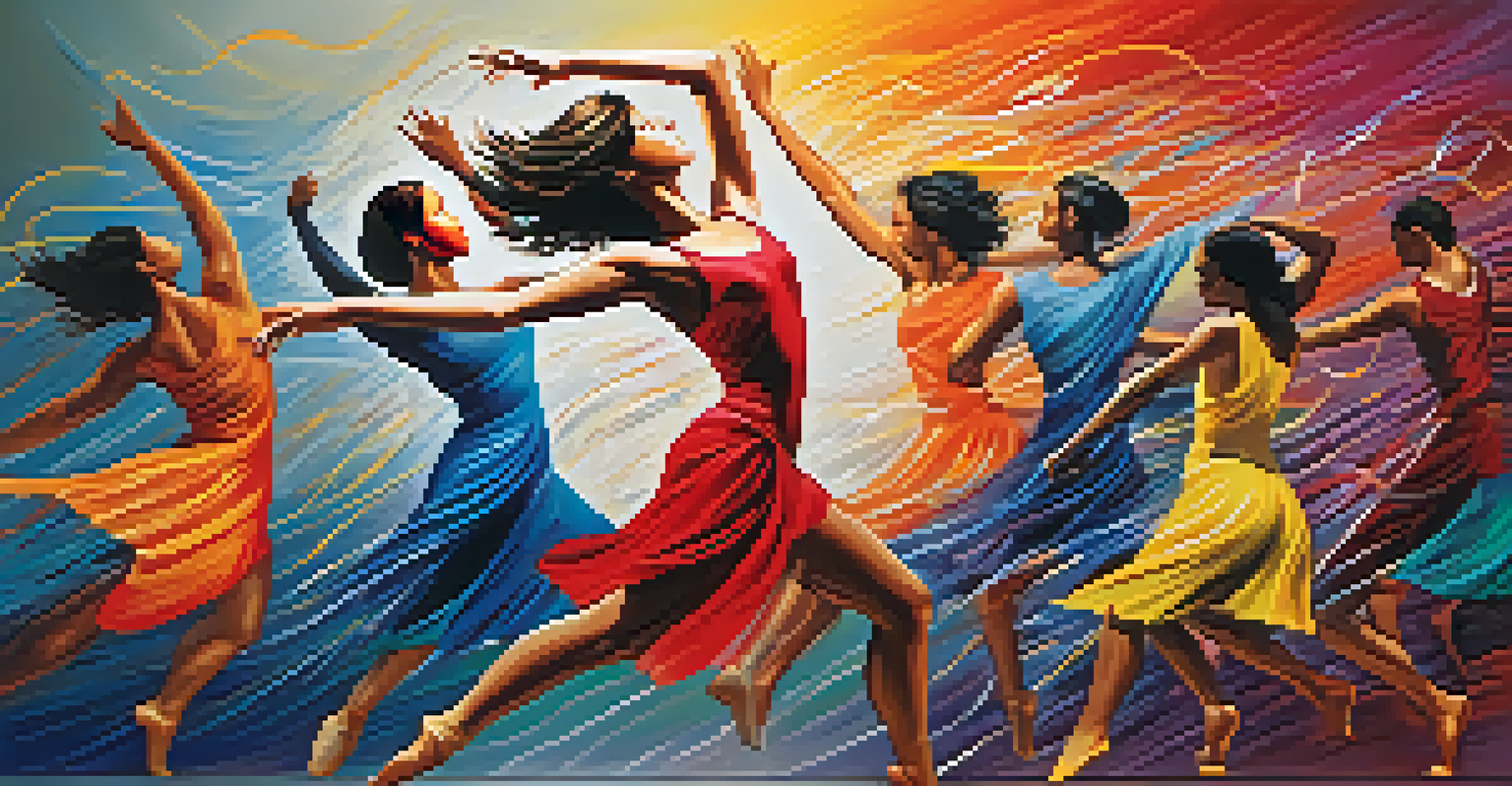Analyzing Different Improvisational Techniques in Dance

Understanding the Basics of Dance Improvisation
Dance improvisation is a spontaneous form of movement where dancers create steps in the moment. It allows performers to express their emotions and ideas without the constraints of choreographed routines. This technique can be found in various dance styles, from contemporary to jazz, and serves as a foundation for creativity and self-exploration.
Dance is the hidden language of the soul.
At its core, improvisation encourages dancers to listen to their bodies and respond to the music or environment around them. Imagine a musician riffing on a melody; similarly, dancers can explore their unique movements and interpretations. This free-flowing approach opens up endless possibilities and can lead to unexpected, beautiful moments on stage.
Moreover, understanding the basics of improvisational techniques can enhance a dancer's overall skills. As dancers practice improvisation, they build confidence, improve their physical awareness, and learn to connect with their fellow performers, creating a dynamic and engaging atmosphere during performances.
Key Improvisation Techniques in Dance
Several key techniques can guide dancers in their improvisational journey. One popular method is 'score-based improvisation,' where dancers follow a set of predetermined rules or themes during their performance. This technique provides structure while still allowing for creativity, making it an excellent tool for both novice and experienced dancers.

Another effective technique is 'contact improvisation,' which focuses on the physical connection between dancers. This style emphasizes shared weight, balance, and movement, encouraging partners to explore their chemistry and responsiveness. Think of it as a dance conversation where each partner's input shapes the outcome, resulting in a unique performance every time.
Improvisation Enhances Creativity
Dance improvisation fosters creativity by allowing dancers to express emotions and explore unique movements without choreographed constraints.
Additionally, 'movement and space exploration' is crucial in improvisation. Dancers are encouraged to experiment with different levels, directions, and dynamics within the space. This exploration can lead to innovative choreography and a deeper understanding of how movements interact with the environment, ultimately enriching the performance.
The Role of Music in Dance Improvisation
Music plays an essential role in dance improvisation, acting as a catalyst for movement and inspiration. The rhythm, tempo, and mood of a piece can significantly influence a dancer's choices and expressions. For instance, a fast-paced tune might prompt energetic, sharp movements, while a slow melody can evoke fluid, graceful gestures.
Improvisation is the ability to take a bad situation and turn it into a good one.
Moreover, improvisation allows dancers to create a dialogue with the music. As they respond to changes in melody or rhythm, their movements can ebb and flow, enhancing the overall performance. This relationship between music and dance is akin to a conversation where both parties influence each other's responses, creating a seamless blend of sound and movement.
Dancers can also experiment with silence and ambient sounds in their improvisation. By removing music altogether or incorporating natural noises, they can challenge themselves to find new ways to express emotions and ideas through movement. This exploration encourages creativity and adaptability, essential qualities for any dancer.
Cultural Influences on Improvisational Dance Styles
Improvisational dance is deeply influenced by cultural backgrounds and traditions, resulting in a rich tapestry of styles. For example, many African and Afro-Caribbean dance forms incorporate improvisational elements that reflect the community's heritage and storytelling traditions. These styles often celebrate the dancer's individuality and connection to their roots.
Similarly, in Western dance forms like jazz and hip-hop, improvisation plays a pivotal role in expressing personal style. Dancers often showcase their unique flair during freestyle sessions, allowing them to stand out in a crowd. This cultural exchange fosters innovation and diversity, contributing to the evolving landscape of dance.
Music Fuels Movement in Dance
The interaction between music and dance improvisation creates a dynamic dialogue that influences a dancer's movements and expressions.
Understanding these cultural influences enriches a dancer's improvisational practice, as it encourages them to explore and incorporate various techniques and styles. By embracing different perspectives, dancers can develop a more nuanced approach to their art, ultimately enhancing their creativity and expression.
Improvisation as a Tool for Personal Expression
At its heart, dance improvisation is a powerful form of personal expression. It allows dancers to convey their emotions, thoughts, and experiences through movement, creating a unique narrative that resonates with both performers and audiences. This process of self-discovery can be incredibly liberating, helping dancers to connect with their innermost feelings.
For many, improvisation serves as a therapeutic outlet. Engaging in spontaneous movement can help release built-up tension and stress, promoting mental well-being. Just as writing in a journal can clarify one's thoughts, improvising in dance can provide insight into one's emotions and perspectives.
Furthermore, the act of improvising encourages vulnerability and authenticity. When dancers let go of expectations and simply move, they invite audiences to witness their true selves. This genuine connection can create impactful moments during performances, leaving lasting impressions on viewers.
Building Confidence Through Improvisational Practice
One of the remarkable benefits of dance improvisation is its ability to build confidence in performers. As dancers practice improvisational techniques, they learn to trust their instincts and embrace their unique movements. This newfound self-assurance translates into stronger performances, both in improvisation and choreography.
Regular improvisation sessions can help dancers overcome their fear of judgment. By creating a safe environment for exploration and creativity, dancers become more comfortable taking risks and trying new things. This experience fosters resilience and adaptability, essential qualities for any artist navigating the ever-evolving world of dance.
Cultural Influences Shape Styles
Improvisational dance is enriched by cultural backgrounds, leading to diverse styles that celebrate individuality and heritage.
Additionally, improvisation encourages a sense of community among dancers. Sharing an improvisational space allows performers to support and inspire one another, creating bonds that enhance their confidence and creativity. This collaborative spirit can lead to a more enriching dance experience, where artists uplift each other.
The Future of Dance Improvisation
As dance continues to evolve, so does the practice of improvisation. With the rise of digital platforms and virtual performances, dancers are finding innovative ways to explore improvisation in new contexts. This shift presents exciting opportunities for collaboration and creativity beyond traditional stage settings.
Moreover, the fusion of different dance styles and cultural influences is shaping the future of improvisational dance. Dancers are increasingly blending techniques from various genres, resulting in an exciting and dynamic movement vocabulary. This openness to experimentation encourages artists to push boundaries and redefine what dance can be.

Ultimately, the future of dance improvisation looks bright and full of potential. As artists continue to explore, innovate, and connect through this unique form of expression, audiences can expect to witness even more captivating performances that challenge conventions and inspire new generations of dancers.